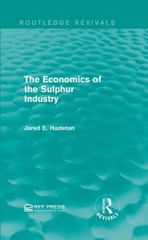Valuation fundamentals Personal Finance ProblemImagine that you are trying to evaluate the economics of purchasing an automobile. You expect the car to provide annualafter-tax cash benefits of
$1,787 at the end of each year and assume that you can sell the car forafter-tax proceeds of
$6,000 at the end of the planned 5-year ownership period. All funds for purchasing the car will be drawn from your savings, which are currently earning 7% after taxes.
a. Identify the cash flows, their timing, and the required return applicable to valuing the car.
b. What is the maximum price you would be willing to pay to acquire the car? Explain.
1. Consider the simple linear model as the DGP of interest: where the e, are i.i.d. normal with mean 0 and variance 1, and the I,'s are non-random. Consider the following procedure: order the observations from highest to lowest according to the value of r. Compute the means of y and a in the top half of the observations and call these y" and I". Then compute the means of y and r in the bottom half of the observations and call these y and F. Then consider the following estimator for B: BW = TH _L a) Show that Aw is an unbiased estimator of f. b) Compute the variance of Bw. c) Show that By is a linear estimator of B. What does the Gauss-Markov theorem tell you the variance of /w must be relative to the variance of the Ordinary Least Squares estimator for 8?Explain the differences in the sampling distributions of x for large and small samples under the following assumptions. Complete parts a and b, a. The variable of interest, x, is normally distributed. Choose the correct answer bokny. Q A. There are no differences, as both large and small samples will have normal sampling distributions. OF. Small samples will have a normal sampling distribution due to the Contral Limit Theorem, but large samples will not have a sampling distribution. O C. Large samples will have a normal sampling distribution due to the Central Limit Theorem, but small samples will not have a normal sampling distribution. OD. There are no differences, as neither large nor small samples will have normal sampling distributions. b. Nothing is known about the distribution of the variable x. Choose the correct arewer below. Q A. Large samples will have a normal sampling distribution due to the Central Limit Theorem, but the sampling distribution of small samples is unknown. O B. Small samples will have a normal sampling distribution due to the Central Limit Theorem, but the sampling distribution of the large samples is unknown. O C. There are no differences, as both large and small samples will have normal sampling distributions. O D. There are no differences, as the sampling distributions for both large and small samples are unknown.QUESTION 7 According to the Central Limit Theorem. the distribution of which statistic can be approximately normal for any population distribution? What condition should the sample satisfy? ). The Central Limit Theorem approximates the sample mean X. It is applicable when the sample size n is sufficiently large. Ob. The Central Limit Theorem approximates the sample size n. It is applicable when the sample size of is not large. The Central Limit Theorem approximates the population mean . It is applicable when the sample size n is not large. Of The Central Limit Theorem approximates the population mean a. It is applicable when the sample size or is sufficiently large, Ce, The Central Limit Theorem approximates the sample mean X. It is applicable when the sample size is is not large. OL. The Central Limit Theorem approximates the sample size n. It is applicable when the sample size or is sufficiently large









